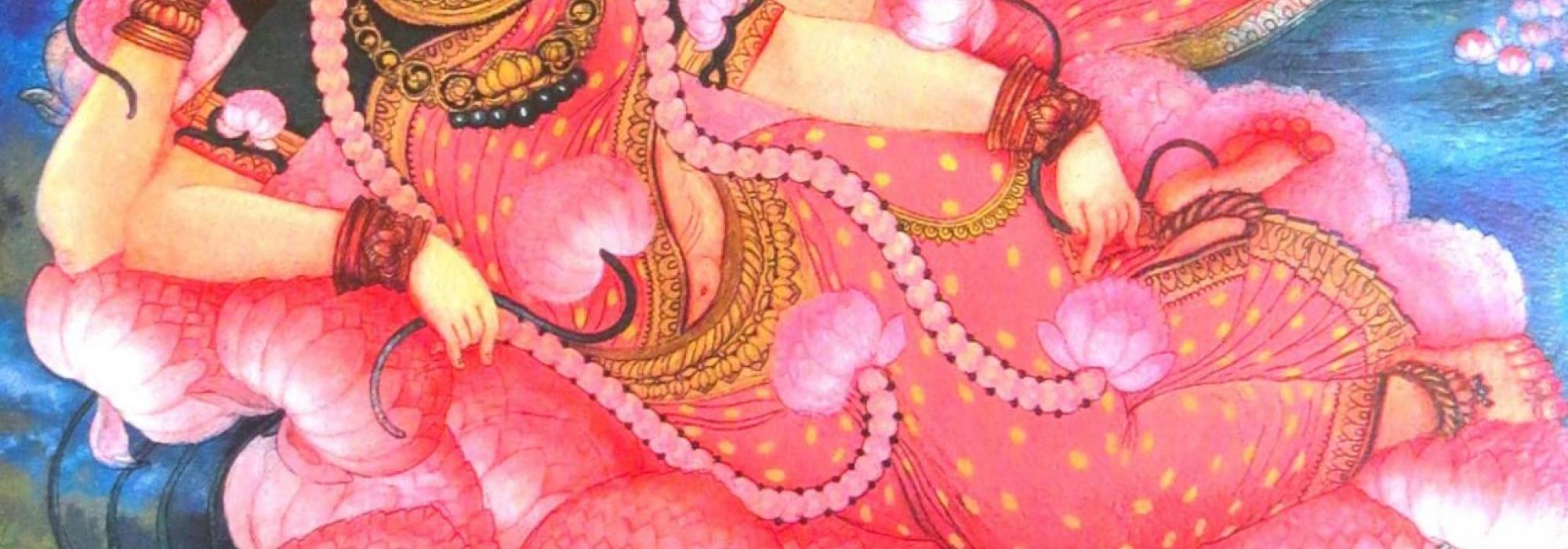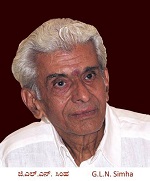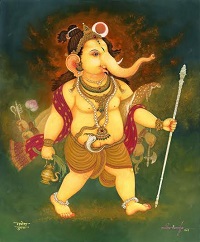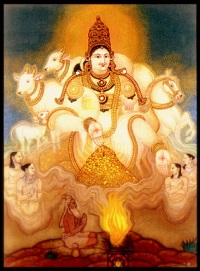Most parts of the Vedas are allegorical and metaphorical in style. Knowledge of this symbolism is the only avenue through which the meaning of the hymns can be accessed. It was necessary for the ancient sages to employ symbolism because of the esoteric content and also because it predates the evolution of systematized language as we now know it. For the same reason everyday words were made to perform multiple tasks: allusions to natural phenomena were mythologized. Different aspects of the Divine Being came to be projected as deities since mankind was already familiar with such deification. In course of time the principles of meaning-assignment became specific and patternized. It is therefore imperative for today’s intellect to transcend linguistic parameters and hark back to remote past when the preoccupation was preservation and transmission of intuitive knowledge and spiritual wisdom. After tools of expression developed adequately, more direct communication became possible, as one finds in the Upaniṣads.
A degree of familiarity with this dynamics underlying the structure of the Vedas s obviously essential for any artist venturing into the stratosphere of Scriptural Art.
The ultimate touchstone is the inner satisfaction of the artist rather than the aesthetic beauty of his creation.
Concentration and meditation are emphasized as preconditions for traditional painting and sculpture in classical texts such as the Viṣṇudharmottara-purāṇa, wherein Art is considered a specialized mode of worship. This formulary is even more relevant to Scriptural Art.
It is this rarefied genre of Scriptural Art that the Mysore-based painter Sri G L N Simha (Gopalachar Lakshmi Narasimha; b. 19 December 1937) has made his forte.
G L N Simha, The Artist
In an environment dominated by Western realistic and surrealistic styles, after mid-nineteenth century the Mysore and Thanjavoor traditionalists in the South and doyens of the Bengal School in the North established themselves as distinct indigenous artists specializing in Scriptural Art. It is to this lineage that G L N Simha belongs. After rigorous training (1954-1959) under masters such as S N Swami, Y Subrahmanya Raju and F M Sufi at the Chamarajendra Technical Institute, G L N Simha went on to specialize in Scripture-based Meditative Art and also evolve his own rich style comprising philosophic symbolism and unusually rich colours. In fact, his lines and colours themselves function as symbols.It is hardly surprising that Sri Simha’s paintings won the first place in the Mysore Dasara Exhibition for five years in succession in 1990s. in later years he won awards from Rotary Ramsons Art Foundation (2003), Karnataka Lalitakala Academy (2004), Karnataka Chitrakala Parishat (2004), Thippaji Chitragar Art Foundation of Shimoga (2011), M T V Acharya Chitrakala Bhavana of Mysore (2011), M V Minajagi Award, Dharwad (2013) etc.
Producers of calendars too have commissioned work by Sri Simha.
A documentary on the work of Sri Simha has been produced by Indira Gandhi National Centre for the Arts for telecast in Doordarshan.
After a brief stint as a staff artist—first with the ‘Tainadu’ group and later with ‘Sudha’ and ‘Mayura’ periodicals in the 1960s—Sri Simha worked as a freelancer for some years and since 1999 has made the village Kalale (near Nanjanagud, Mysore) his home.
Sri Simha is married (1969) and settled with his two children—a son and a daughter—in rustic environs pursuing his mission of enlivening the Vedic lore through the painter’s medium.
Sri Simha was initiated into the techniques of Aṣṭāṅga-yoga-sādhana by the renowned preceptor Sri Srinivasacharya of Lakshmipuram, Mysore. What gave an extended dimension to Sri Simha’s visualization was his intense study of scriptures in the traditional method and his meditative nature. Prolonged meditation precedes his conceptualization. Thus, each creation of his is also a personal statement. Intense involvement in the theme and mastery over craftsmanship have combined to make each of his creations a unique experience.
Pointers to symbolism of forms of deities enshrined in Dhyāna-ślokas are an invaluable aid to meditation.
The wholeness and symmetry of the forms of deities indicate the timelessness of being and becoming.
Sri Simha’s abiding interest in Scriptural Art has during the years 2000-2014 resulted in several series on Vedic and Epic themes, made possible by the sustained support extended by Ramsons Kala Pratishthana of Mysore. Sri R G Singh, Secretary of Ramsons Kala Pratishthana, and Sri M B Singh, Advisor to the Pratishthana, are widely known for their connoisseurship and their readiness in promoting and nourishing traditional painting and sculpture. Encouraged by the support from the Pratishthana, Sri Simha produced a series of paintings visually interpreting the verses of Śrīsūkta of the Ṛgveda in 2001. The series won wide acclaim and paved the way for similar interpretative series on Vedic and Epic lore such as Puruśasūkta, Vāgambhraṇīsūkta, Rudrādhyāya, Gaṇeśapurāṇa, Kālikāpurāṇa, and two series on Tantraśāstra. In addition to these eight series (2001-2013), Sri Simha has also created over fifty stray paintings, many of them being depictions of different deities as described in the Āgamas.
Sri Simha’s effective use of primary as well as blended colours reflects a high degree of technical mastery.
Since his boyhood, Sri Simha had a deep interest in scriptures and epics. Over the years this interest became an all-encompassing passion, guiding him in his intellectual and artistic journey.
G L N Simha’s Scriptural Paintings Series: A Conspectus
- Śrīsūkta (15 paintings)
- Puruśasūkta (11 paintings)
- Vāgambhraṇīsūkta (8 paintings)
- Gaṇeśapurāṇa (12 paintings)
- Rudrādhyāya (10 paintings)
- Kālikāpurāṇa (6 paintings)
- Daśamahāvidyā (10 paintings)
- Śaktisvarūpiṇī (9 paintings)
Stray Paintings (Select List)
- Kṣipra-prasāda-gaṇapati
- Bāla-mukunda
- Rādhā-Kṛṣṇa
- Laya
- Birth of Aśvinī-duo
- Virāṭ-puruśa agni
- Kālabhairava
- Irādevī-Kāśyapa
- Amṛteśvara
- Gaja-saṃhāra-mūrti
- Hanūmān
- Sage Bharata
Simha’s Scriptural Paintings
While an episodic theme or two have occasionally been addressed by artists, executing a whole series covering a whole Vedic sūkta or epic text is uncommon. Equally remarkable has been the transference of the medium of visual communication to higher reaches of esoteric symbolism.
Sri Simha finds in the Śrīsūkta verses not merely celebration of rich life-sustenance endowed by Nature, but also the ordained responsibility of an attitude of reverence and non-overexploitation. Kindliness of mother and other attributes are vividly brought out in the Śrīsūkta series. What is routinely narrated as the Goddess of Prosperity connotes for the artist a primal mingling of the potential and the kinetic forms of Energy. In one notable painting the artist juxtaposes the ascent of the sublime and dissolution of the ignoble.While some verses of the Puruśasūkta outwardly describe facets of creation of the universe, the artist beholds in it a progression of inbuilt impulses such as knowledge pursuit, dominance, survival and gregariousness, all of which together constitute life.
An unusual series is devoted to the well-known Vāgambhraṇīsūkta of the Ṛgveda and explores the centrality of Vāk or Logos as the source of all energy and creativity encompassing multiple universes. The motif of Vāk is harnessed also to symbolize bondage and liberation.
In a rare departure from common practice, in this Sūkta the Goddess of Speech speaks about Herself in the first person, and Her dominant role in the affairs of men and of other worlds. Sri Simha’s elaboration of this theme in his paintings goes on to establish a correlation between human faculties and divine realms.
The rich symbolism behind the iconography of Gaṇeśa has inspired a fascinating series, drawing inspiration from the Gaṇeśapurāṇa. The aesthetic appeal of Sri Simha’s portrayal of Gaṇeśa, the most adored deity, is especially alluring.
The series on Rudrādhyāya, in addition to depicting the pervasiveness of the Divine Being, provides pointers to modes of contemplation. In this series, the device of an observant narrator of the multifaceted exuberance of the Divine Being is innovative and enriching.
The Tantra-based series colourfully captures both epic narratives and the Tantric rubric of Sādhana. Paintings such as the one depicting Samudra-manthana are particularly memorable.
The Kālikāpurāṇa series draws attention by the interplay of multiple strands of the narrative.
The Śaktisvarūpiṇī series depicts in rich detail the varied forms of Devi as described in the Tantraśāstra texts.
A unique feature of Sri Simha’s scriptural paintings is that each creation not only pictorializes the textual import of the scripture, but also elaborates the extended and derivative meanings, indicating how the purport of the verses is reflected in actual life at the mundane level.
These paintings are products of inner vision rather than of mere cerebration.
















































